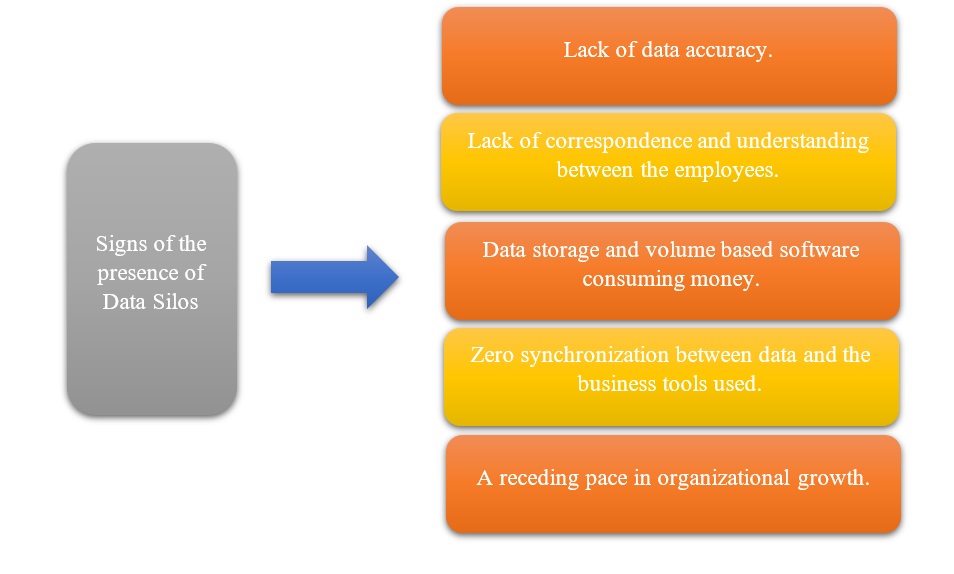What is Data Silo and How is it Breaking Your Business Operations?

Many of us might be aware of the terms AI, CRM, Data Integration, Digital Transformation, and so on, which are commonly used in the IT sector and businesses. There is a software as a solution to deal with every tech issue in an organization. But sometimes, wrong tools, cluttered software and, other such issues give rise to a bigger problem, Data Silos. What is Data Silos? Is it harmful to your company? How to recognize data silos? Let us get the answers to these questions and reach for the solution to tackle this technological menace.
What is Data Silos?
When a group of raw data is accessible or visible only to a specific department in an organization and remains opaque to the rest, it is called Data Silo. This is one of the common issues which can crop up in any organization and kill the required transparency between different departments. Recognizing Data Silos can be a task, mostly because many times an organization is unaware of its presence. So, are there any noticeable signs suggestive of its presence?

Two of the most common sequence of events in which organizations suffer Data Silos are:
- A Widely Expanded Organization – When an organization is vast, it is bound to be spread across the world with multiple extensions and a number of departments. The hierarchical distribution of any data across each department and to such an expanse becomes difficult. The data thus remains limited to a certain department without the knowledge of the others, thereby creating a lack of transparency and trust between employees.
- Technological issues – Technological advancement is important across an organization. Data integration, connecting tools and, software for an efficient performance is imperative for the growth of any company. When a certain department is trained for the use of these advanced tech tools, the left-over branches suffer from the lack of it.
Why is Data Silos Considered Harmful for Businesses?
By now it is evident that data silos are in every way ruinous for a business’ growth. Even before the term Data, the word Silo has been in use in the world of business and signifies separated departments and people within an organization. The lack of inter-departmental conversations is the building block to a company’s downfall. Let us read forth to delve into a clearer understanding of how Data Silos can affect businesses:
- It hampers customers’ experience – When a customer approaches an organization with service issues, various departments such as marketing, sales, billing etc. come together to assist through interaction. During this process, the isolated data can break the chain of the interaction leading to the service provider losing track of the customer’s story. This further leads to a customer getting frustrated.
- Lack of Collaborative work environment – Data isolation leads to teams working in their respective spheres leading to a divided or grouped organization. Organizational growth is directly related to a transparent work atmosphere, which is not the case due to data silos posing as a barrier between employees.
- A Partial outlook of the Company – Bringing together the company information post-task consolidation can be laborious. Data Silos are like impediments preventing you from achieving a 360-degree view of your company.
- Data Accuracy – An organization’s acceleration towards growth is defined by the technological tools it uses to collect and use data for a company’s benefit. Hence, data acts as an important aspect. But if a tool sits isolated which can lead to outdated data, your company’s worth in the market can suddenly get negatively affected.
How to Eliminate Data Silos?

Breaking down Data Silos is a difficult task. But done strategically, it can help an organization to recover from its bad effects-
- Introduce software that can gather and integrate all the isolated data at a single easily accessible location. All the departments should be able to access the information, thereby using the centralized data for a company’s profit.
- Teamwork stands as the strongest reason for a company’s growth and success. A collaborative effort can be achieved by ensuring that all the streams of an organization can understand and use the new data or tools.
- Departments can work together to weed out the outdated data by integrating different business applications to achieve one unified purpose.
- A protocol should be designed, defined by objective-oriented data gathering.
- Native integration should be used to tackle the tech stack.
- A collaborative work culture should be enforced upon all the departments across an organization.
The elimination of unused data is one step towards breaking down Data Silos. Cloud adoption thus comes into the picture. In a recent report, 72% of the firms find it extremely difficult to manage multiple CRM software and data silos across their geographical expanse. Yet, it is the availability and accessibility of all the data to all the branches of a company that governs a company’s overall performance.